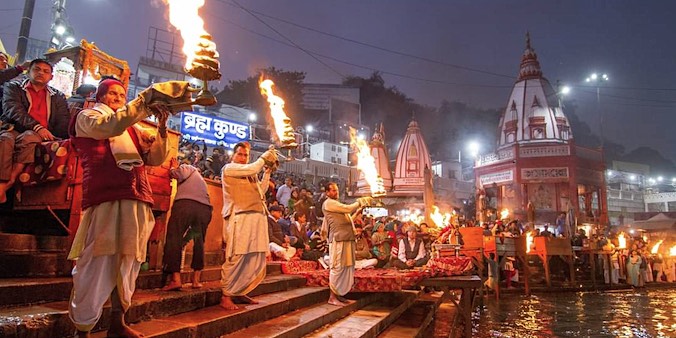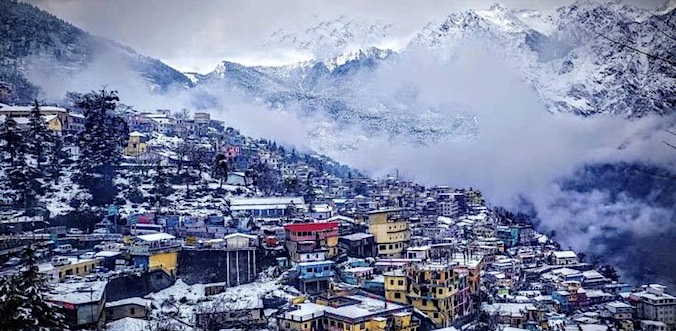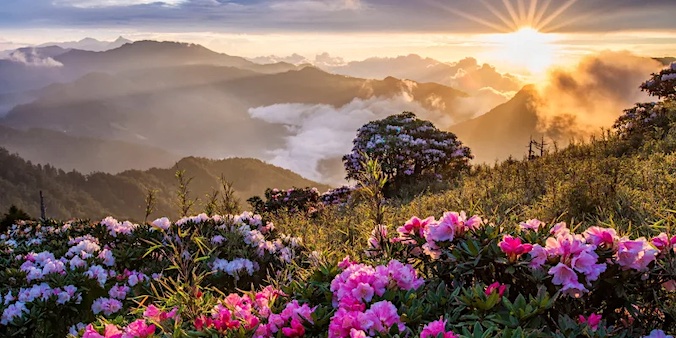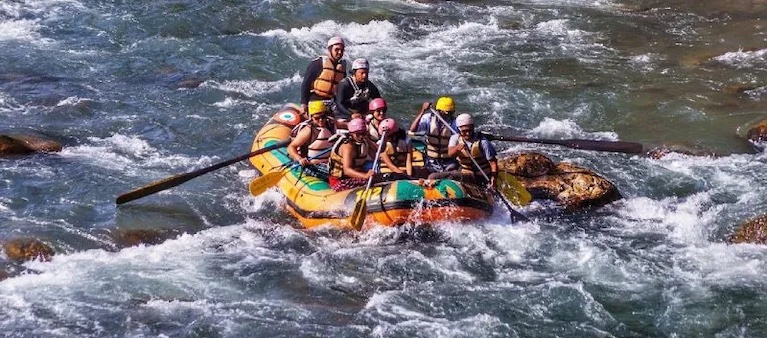VALLEY of FLOWERS & KUARI PASS TREK
Trekking tour - 16 days/ 10 days trekking
About UTTARAKHAND
Uttarakhand is a state blessed with an enormous diversity of cultures and landscapes. Just like Himachal Pradesh, Sikkim, Bhutan and Arunachal Pradesh, it spans the whole altitudinal range from steamy jungle where tigers and wild elephants roam to some of the highest peaks of the Himalayas. One of them is Nanda Devi (7816 m, 25,636 ft), the highest mountain that lies fully in India.
TREKKERS’ PARADISEThe higher reaches of the Uttarakhand Himalayas are a mecca for trekkers. You can follow the herders up to the high bughyals (alpine meadows) and trek up to passes that in the old days gave access to Tibet. They reward you with some of the best glacial vistas in the Himalayas. Although the number of Indian trekkers is increasing, these areas still don’t get that many visitors as the much more known treks of Ladakh and Himachal Pradesh.
Read more…Read less
Wildlife enthusiasts find a treasure trove of biodiversity here, partly protected in national parks and wildlife reserves throughout the state. Most notably, Jim Corbett National Park and Nanda Devi & Valley of Flowers National Park. Jim Corbett National Park is named after A famous British hunter-turned-conservationist. It is well known and popular as it is one of the tiger parks in India that is easiest to reach from Delhi. Apart from being home to a wide array of mammals, birds and plant life, it has very appealing landscapes and a well-laid out infrastructure of jeep trails. Nanda Devi & Valley of Flowers National Parks are two formerly separated but now joined protected areas lying almost completely at or higher than 3500m (11.500 ft). They can be explored only on foot.
HINDU PILGRIMAGETo Hindus – who make up 83% of the state’s population – the higher reaches of Uttarakhand are known as Dev Bhoomi – the abode of the gods. This is not just folklore, as present day Hindu culture finds many of its roots in this area. It is believed that the sage Vyasa scripted the Hindu epic Mahabharata here. In the Middle Ages, the Hindu kingdoms of Garwhal and Kumaon made up the western and eastern part of the present day state, respectively.
Millions flock every year to the many pilgrim sites that the state harbors. Easily accessible places like Rishikesh, Haridwar are not only popular with Hindu pilgrims but also host numerous ashrams and yoga schools that cater mainly to foreign visitors. Much higher up, you can witness die-hard Hindu pilgrims and saddhus dipping themselves in ice-cold waters where Mother Ganga (Ganges) emerges from the mouth of a glacier.
BREATHTAKING VIEWS, COZY RETREATSTraveling by car, you may experience Uttarakhand as a never-ending series of curves and switchbacks, but after each of these bends new views and sights await you. The mountains are covered in forests and green fields and especially in the winter months you get breathtaking views of the snow-clad Himalayas on the border with Tibet (China). Uttarakhand counts numerous so-called hill stations, towns situated at medium elevation levels that have been welcoming tourist since the British era. These hill stations are popular with domestic tourists, but have a lot to offer to ‘foreigners’ as well. In and around them, you can find (with some effort) hidden lodges, boutique hotels and family-run retreats with a high degree of the ‘Hotel California factor’: you can check in any time, but you may never want to leave.
Region
Uttarakhand
(India)
Best Time
May-June &
Sept-Nov
No. Of Days
16 days, 10 days trek
Trip Character
Trekking tour
Sleeping Altitude
290 - 3310 m
Trek Character
Camping trek
Level: 3
Price
INR XXX/ $ XXX
ABOUT THIS TOUR
On this tour, you’ll travel by train and car from Delhi to the Garhwal Himalayas in the state of Uttarakhand. You’ll travel up along the mighty and holy Ganges along some of the most sacred and popular Hindu pilgrims places, such as Haridwar and Rishikesh. Here, you will witness offering rituals on the banks of Mother Ganga.
Following one of the Ganges’ main tributaries, the Alaknanda River, to its upper reaches, you’ll reach Badrinath, one of the four most important Hindu pilgrim places in the high Himalayas (3100m). Here, you’ll join saddhus (ascetics) and devotees on their trek up to the holy lake Hemkund and explore the famous Valley of Flowers. The latter is a national park, not only famous for its botanical diversity but also for its setting amidst a range of very tall glaciated peaks.
After this you’ll make one of the most rewarding treks in the Indian Himalayas in terms of views, the Kuari Pass trek. From Auli, not far from the pilgrims’ town of Joshimath, you’ll trek up over bugyals – verdant alpine meadows where semi-nomadic herders tend to their sheep and goats – and through magnificent forests to the Kuari Pass at 3640m. Enjoying more and different views, you’ll descend on the other side to the remote and picturesque villages of Jangi and Ramni.
After returning to Rishikesh by car, you’ll do an exciting rafting trip on the Ganges, before taking the train back to Delhi.
YOUR custom-made TRIP
The tour described here, as well as the other ones on our website, are mainly meant as suggestions. We would be happy to offer you a travel proposal that fully meets your personal demands and expectations. That means that you choose where you want to go, what level of accommodation and type of transport you want and what activities you prefer.
Please let yourself be inspired by this and other trips on our website and then drop us a line (or call us) to explain your travel wishes. We will be happy to help you put together the perfect trip. You can reach us over e-mail, Messenger, Whatsapp or mobile phone.
EXTENSIONS & VARIATIONS
Apart from the tour as described here, you could consider the following add-ons and changes:
- On all tours In India we can organise one or two days sight-seeing in Delhi, either at the beginning or the end of the tour. You would be taken to Connaught Place, the center of New Delhi, the bustling beehive of Old Delhi, the Red Fort, Qutub Minar (an old minaret), The Akshardam Temple and more if you like.
- For those who want to see more of the Indian plains we can organise a one or two-day trip to Agra (site fo the Taj Mahal) or a three to five-day Golden Circle tour, taking in Delhi, Jaipur and Agra.
- Include another short trek on which you walk up to the source of the Ganges at Gaumukh near Gangotri. This can be done at the beginning or end of this tour. It adds six days in total to the tour.
- If trekking is not your cup of tea we can show you Uttarakhand and some of the beautiful high pilgrim places by car and by doing less strenuous day walks only.
ITINERARY
-
Day 01: Delhi - Haridwar (91,3 km/ XXX h)
Early morning transfer to the railway station where you board the Shatabdi Express to Haridwar. On arrival our guide and driver will welcome you and take you to your hotel. In the evening you can witness an aarti ceremony at the Ghats (banks) of the Ganges River. Overnight in or near Haridwar. Altitude 215 → 290m. -
Day 02: Haridwar - Joshimath (>220 km/ 9 h)
Drive along the magnificent Alaknanda River to Joshimath, passing the two very famous prayags (confluences) of Dev Prayag and Rudraprayag. Joshimath is an important pilgrims place. Overnight in Joshimath. Altitude 290 → 1800m. -
Day 03: Joshimath - Badrinath (42 km/ 3 h)
At breakfast you’ll be astounded by the sights of all the glaciated peaks around. Later in the day his will get even better as you follow the Alaknanda River to Badrinath, another one of the four main pilgrim towns in Garwhal. You can visiti the town and its Vishnu temple, and then continue till the road end at Mana, a small village inhabited by shepherds of mixed Indian and Tibetan origin. Overnight in camp or lodge at Govindghat, XXX downstream from Badrinath. Altitude 1800 → 3100 → 1830m. -
Day 04: Trekking Govindghat - Ghangaria (trekking 15 km/ 5-6 h)
Today your trek starts. You’ll walk up to along the Laxman Ganga over a well-trodden trail, accompanied by pilgrims heading for the holy lake of Hemkund. The ascent is 1200m so take your time! Overnight in camp or lodge at Govindghat. Altitude 1830 → 3050m. -
Day 05: Trekking Ghangaria – Hemkund – Ghangaria (15km/ 5-6 h)
Today you follow the pilgrims to the holy lake of Hemkund. It’s a stiff 1330m climb. As no camping is allowed beyond Ghangaria you’ll retrace your steps to your camp at Ghangaria. Altitude 3050 → 4330 → 3050m. -
Day 06: Trekking Ghangaria – Valley of Flowers – Ghangaria (14km/ 5-6 h)
Today you follow a much quitter trail into the famous Valley of Flowers. You can spend most of the day here exploring the meadows and forests. Overnight at camp in Ghangaria. Altitude 3050 → 3650-3950 → 3050m. -
Day 07: Trekking Gangharia - Govindghat & car Govindghat - Auli (15,4 km,/ XXX h)
You trek back to Govindghat and ride the car till Joshimat, where you follow a smaller road up to the small wintersports town of Auli. Overnight in Auli. Altitude 3050 → 1830 → 2750m. -
Day 08: Auli – Chitra Kantha (15 km/ 6-7 h walking)
Early Morning you can enjoy the sunrise on the Nanda Devi Peaks. After meeting your trekking crew, you start the trek, gradually ascending over the large Gurson bugyal (alpine meadow) and passing a pristine small lake to a camp site at just above 3300m. Overnight in camp. Altitude 2750 → 3310m. -
Day 09: Chitra Kantha – Kuari Pass - Dakwani (12 km, 4 h)
A gradual climb brings you to the Kuari Pass, at (3640m). There are several very good viewpoints along the way from where you can appreciate the many seven-thousanders that surround Nanda Devi sanctuary. In particular Nanda Devi (7816 m) and Nanda Devi East (7434 m). But the pass itself beats them hands-down. Descending from the pass, and passing a small shepherds camp, you reach a forest clearing called Dakwani, where camp is made. Altitude 3310 → 3640 → 3300(3185?)m. -
Day 10: Dakwani – Pana Village (13km/ 6-7 h)
The trail leads down to a small river, then steeply up to a small ridge, and down again to an impressive waterfall. Ascending again, we reach Sathholi meadow, carpeted in the spring with lovely wildflowers. A final descent leads to our camp above the village of Pana. Altitude 3300 → 2450m. -
Day 11: Pana Village - Jhangi (13km/ 3-4 h)
Today is mainly descending through lovely forest with clearings to Jhangi Village. You should arrive at camp by lunchtime, having the afternoon for visiting the village. Altitude 2450 → 2000m -
Day 12: Jhangi - Ramni (16 km, 5-6 h)
The first four hours will be uphill today, trekking up through forest of rhododendrons and oaks and meadows with superb alpine flora. After crossing a pass at 3020m, with again great views, you descend to the village of Ramni, where the trek ends. Overnight in camp. Altitude 2000 → 3020 → 2550m. -
Day 13: Ramni - Nand Prayag (29km, 3-4 h driving)
Your car will take you down over rough road down from Ramni to the larger town of Nand Prayag, at the confluence of the Alaknanda and the Nandakini River. Overnight in Nand Prayag in a hotel. Altitude 2550 → 915m. -
Day 14: Nand Prayag – Shivpuri (175 km, 5-6 h driving)
After breakfast we drive alongside the Alaknanda River and then from Dev Prayag alongside the Ganges to a rafting camp on the beach near Shivpuri. Overnight camp on a lovely beach.Altitude 915 → 470m. -
Day 15: Shivpuri – Rishikesh (175 km, 3-4 h)
Today you continue your journey floating down the Ganges on a raft to Rishikesh. Surrounded by hills and bisected by the rushing Ganga, it is often termed the ‘Yoga Capital of the World.’ In the afternoon you can witness the aarti ceremony, where thousands of candles and marigold flowers are floated on the holy Ganges. Overnight in Rishikesh. Altitude 470 → 340m. -
Day 16: Rishikesh – Haridwar - Delhi (car XXXkm/ 1 h; train XXX h)
After breakfast you will be driven to Haridwar where you will board the train to (XXX hours). XXX .Altitude 340 → 215m.
HIGHLIGHTS OF THIS TOUR

HARIDWAR and RISHIKESH

JOSHIMATH

VALLEY of FLOWERS




